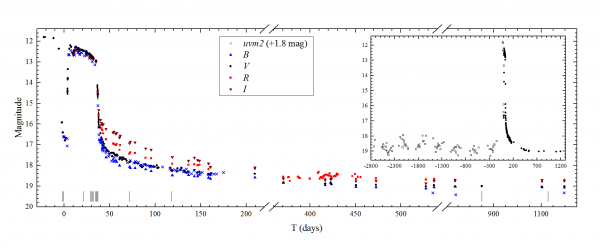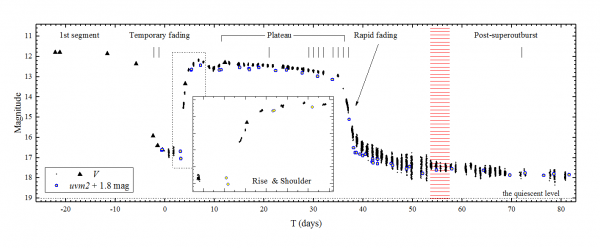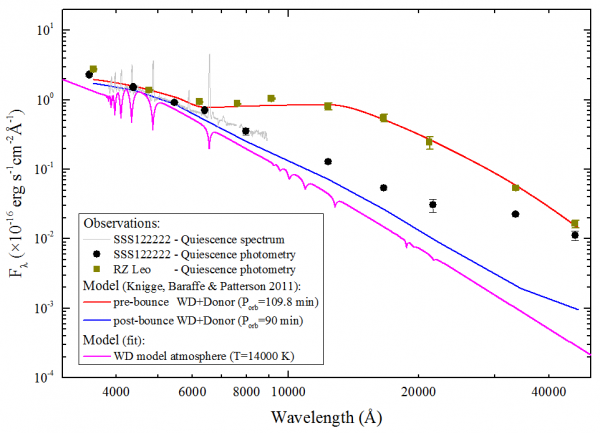The highly-evolved post period-minimum dwarf nova SSS J122221.7−311525
Cataclysmic variables are binary systems consisting of a white dwarf as primary and a low-mass main-sequence star or a brown dwarf as secondary component. According to standard evolutionary theory, cataclysmic variables evolve from longer to shorter orbital periods until a minimum period is reached (~80 min) when the donor star becomes of a substellar mass and partially degenerate, resulting in a kind of a brown-dwarf-like object. The star is driven out from the thermal equilibrium and at some point its radius stops contracting in response to mass loss and even grows. As a result, the binary begins to evolve towards longer orbital periods. The ”period bouncers” are such cataclysmic variables that have passed beyond Pmin and are evolving back toward longer periods, with the donor star now extremely dim. This has long been predicted to be the “graveyard” and current state of 70 per cent of all cataclysmic variables, however only about a dozen of more or less robust candidates for such period bouncer systems have been identified until now, out of a thousand of known cataclysmic variables. I have been working to improve this situation shedding light into the late evolution stages of cataclysmic variables through the observation of interesting short-period binaries (Kato et al. 2016; Namekata et al. 2017). In particular, I have recently initiated a new project to systematically search for period-bounce candidates by means of time-resolved photometric and spectroscopic observations over a wide range of wavelengths.
As part of this work, we have recently reported extensive 3-yr UV–optical–NIR photometric and spectroscopic observations of the WZ Sge-type dwarf nova SSS J122221.7-311525 during its unusual double superoutburst, the following decline and in quiescence. The data used were obtained with the ESO/VLT and the 6.5-m Magellan Telescopes in Chile, the 4.2-m William Herschel Telescope on La Palma, the 2.1 and 0.84-m telescopes of the Observatorio Astronómico Nacional at San Pedro Mártir (OAN SPM) in Mexico, and many other smaller telescopes.
The light curve of the superoutburst of SSS J122222 in all the available optical and UV filters.
A superoutburst segment of the light curve in the V and uvm2 filters.
The spectroscopic and photometric data revealed a very low mass ratio of the system, q<0.045. With such a small mass ratio even if the white dwarf was close to the Chandrasekhar limit the donor mass must be below the hydrogen-burning minimum mass limit. The observed IR flux in quiescence is indeed much lower than is expected from a cataclysmic variable with a near-main-sequence donor star. This strongly suggests a brown-dwarf-like nature for the donor and that SSS J122221.7−311525 has already evolved away from the period minimum towards longer periods, with the donor now extremely dim. The relatively long orbital period of SSS J122221.7−311525 (109.8 min) suggests that it is by far the most evolved post-period minimum cataclysmic variable known to date.
Theoretical SEDs of pre- and post-bounce CVs, based on the models of Knigge et al. (2011), shown together with the photometric and spectroscopic data of SSS J122222 (period-bouncer) and RZ Leo (a pre-bounce CV) in quiescence.
For more details see the article “The remarkable outburst of the highly evolved post-period-minimum dwarf nova SSS J122221.7−311525”, 2017, MNRAS, V.467, pp. 597-618



